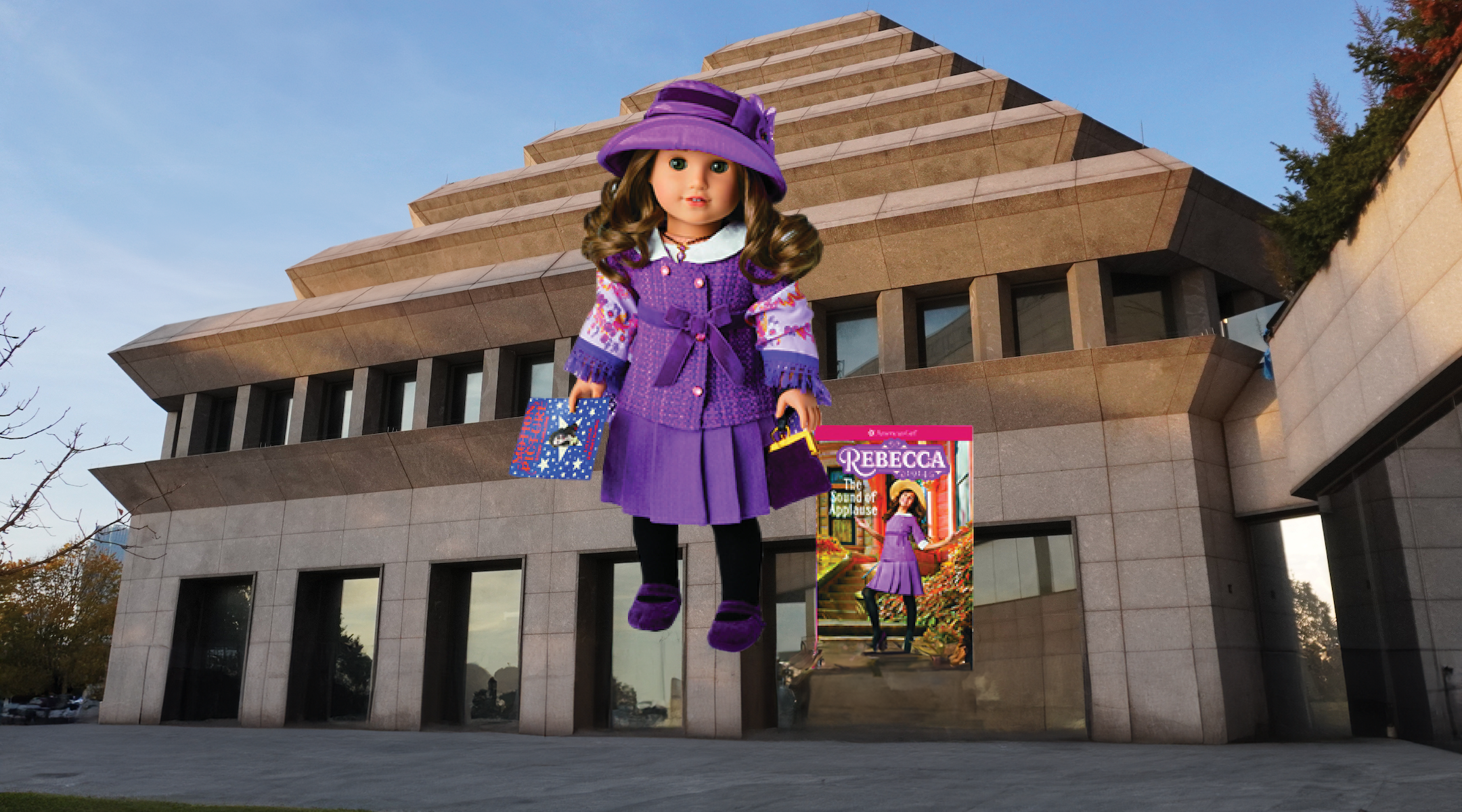(New York Jewish Week) – Born in 1905, Rebecca Rubin was a Russian-Jewish immigrant who lived on the Lower East Side. Typical of girls her age, she attended public school, lit Shabbat candles with her siblings, watched her father conduct business at his shoe store and loved going to the movies.
And now, this Sunday, the Museum of Jewish Heritage-A Living Memorial to the Holocaust will host a family-friendly event designed to celebrate her life and that of other young Jewish immigrants. On the event’s agenda are special tours, crafts and a panel discussion about Rebecca’s story, as well as others like her who lived in New York in the early 20th century.
But here’s the thing: Rebecca Rubin is not a real person. She is an 18-inch tall American Girl doll — who, like the others in the brand’s uber-popular series of historical dolls, represents the life of a girl who lived during an important period of American history. The aim of American Girl, which launched in 1986, is to inspire “girls to grow up with courage, confidence and strength of character,” according to its web site, and invites young children to learn about history on their own terms.
That mission, as it happens, dovetails nicely with that of the Battery Park-based museum. “We celebrate Jewish life before, during and after the Holocaust, and immigration is a big theme of what we do,” said Joshua Mack, the Museum of Jewish Heritage’s vice president of marketing. “I had been thinking about our immigration pieces and ways to get people into the museum so that they can discover what we do, especially younger people. What’s amazing about American Girl dolls is how historically relevant they are. It’s a way for so many children to get proper history, so it totally fits into our lane.”
Sunday’s “Rebecca Day” is the museum’s first-ever event dedicated to a doll. The idea originated nearly 10 years ago when Mack took his own child, Willa, to the Tenement Museum — a Lower East Side “living history museum” that tells the story of New York’s immigrants by recreating the conditions they lived in — and they toted along their Rebecca doll.
“It seemed like a great way to celebrate Jewish heritage and get fans and enthusiasts to visit us and learn more about the museum,” Mack said of Rebecca Day, adding that when he pitched his team — who are mostly Gen-Z and millennials — they immediately latched onto it.
As one of 12 historical dolls in the active lineup of historical American Girls, Rebecca was the first American Girl doll with a Jewish story when she came on the scene in 2009. (This spring, American Girl released 1990s twin dolls Isabel and Nicki Hoffman, whose father is Jewish.) “The much-anticipated latest addition to the American Girl series of historical characters, Rebecca goes on sale May 31 along with six books about her life,” JTA’s Sue Fishkoff wrote at the time. “No cheap date, she costs $95 with one book, or $118 if accompanied by the complete set.” (Inflation has been kind to American Girl: The Rebecca set today costs $146.)
Each of the dolls in the series comes with period clothing and accessories to flesh out her life story, as well as a set of books that describes the year in their lives when they turn 10. Rebecca’s line includes props like a menorah, Shabbat candles and a Russian-style shawl, as well as a purple bouclé outfit and satin purple hat.
Sunday’s event is also also designed to get people in the building to view the museum’s new exhibit, “Courage To Act: Rescue in Denmark,” its first-ever exhibit geared towards children, Mack said. The interactive exhibit tells the story of how Jewish and non-Jewish communities in Denmark banded together to save 95% of the Danish Jewish population from the Nazis, including by transporting them on rescue boats to Sweden — an endeavor helmed by 22-year-old Henny Sinding Sundø.
Rebecca Day — which is free, though $10 donations are encouraged — includes kid-friendly guided tours of the museum’s exhibits, as well as a festive lunch of latkes for kids and their dolls at the Lox Cafe, the museum’s restaurant, and Hanukkah crafts like dreidel-decorating.
A highlight of the event is a discussion with Jacqueline Dembar Greene, the author of 11 American Girl novels featuring Rebecca Rubin. She plans to answer questions about Rebecca’s story and about what life was like as an immigrant in 1914. Some of the research she did for the books was conducted at the Museum of Jewish Heritage 15 years ago, Dembar Greene told the New York Jewish Week, adding that other stories were lifted from her own family’s experience as Russian Jewish immigrants in the 1920s.
“I tried to write it as if there were readers who didn’t know much of anything,” Dembar Greene said. “But then, for the kids who were Jewish, I wanted to make sure that they felt that they learned a little extra something and see their own lives reflected in some of the traditions.”
American Girl is not sponsoring Rebecca Day at the museum. But spokesperson Julie Parks said the company is “excited” about the event, particularly the fact that Dembar Greene “will be on hand to share how Rebecca, a first-generation Jewish American growing up in early 20th-century New York City, made her own positive mark on the world.
“American Girl is a brand rooted in story,” Parks said, “and each of our beloved characters, like Rebecca, has helped to create a sense of connection and community among our fans.”
Dembar Greene said one of the biggest challenges in writing the Rebecca books was nailing just how observant the Rubin family might have been — Rebecca’s father opens his shoe store on Shabbat, for example, but her parents wouldn’t let her go to a movie then — while acknowledging that part of the immigrant experience at that time was assimilating to American culture. It’s one of the themes that Rebecca contends with throughout the series.
“I tried to reflect that the most important thing in the families, that was not changeable, was the acceptance of moral traditions,” she said, adding that “tikkun olam, making the world a better place, and the way you treat other people,” are major factors in both Rebecca’s story and Jewish life in general.
“Partly why these books are still popular and still very relevant, even though the story is based so long ago, is that we have new immigrants coming in and contributing to the American story their energy, their drive, their fresh ideas and new ways of looking at things that drive progress,” she added.
“Rebecca Day” will take place at the Museum of Jewish Heritage at 36 Battery Pl. on Sunday, Dec. 3 from 1 p.m. to 4 p.m. Register here.
The New York Jewish Week brings you the stories behind the headlines, keeping you connected to Jewish life in New York. Help sustain the reporting you trust by donating today.





